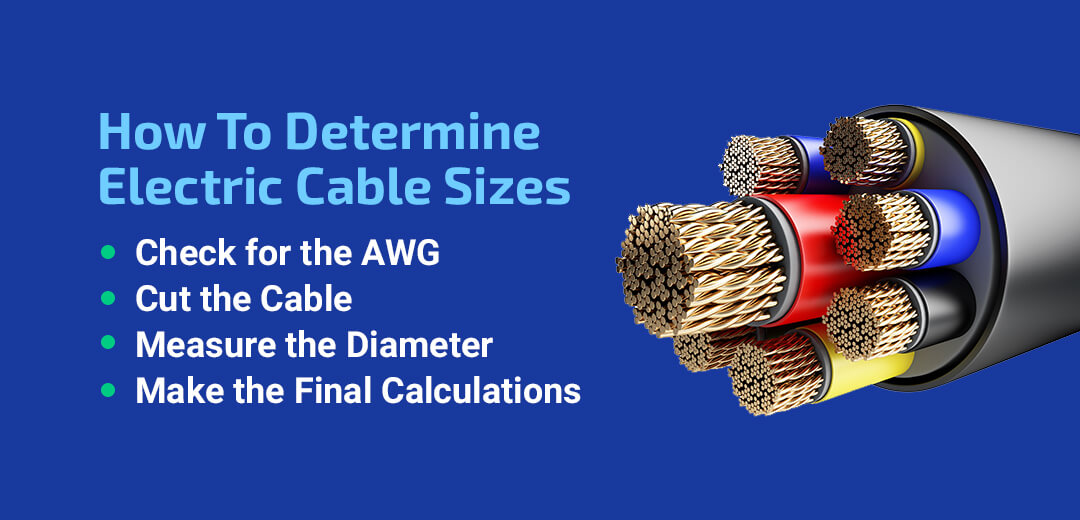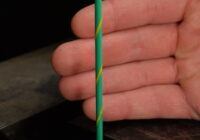
Jun 14, 2022
How to Identify Electric Cable Sizes

Electric wiring runs through properties to power lights, electronics, HVAC systems and more. To do this, electric systems use cables, which are groups of wires insulated together. They provide electrical currents with a low-resistance path to travel through.
Whether you’re installing a new electrical system or repairing an existing one, it’s crucial to understand electric cable sizes. The different sizes, or gauges, can conduct various amounts of currents. You need to use the correct cable size to keep your wiring safe and reduce the risk of fires.
Here is an overview of how to measure cable size for your project.
The Importance of Having Accurate Electric Cable Size
Choosing the correct cable size is critical for you and your project’s safety. Because each cable can conduct different current amounts, you need to select the appropriate size for your needs. For instance, if you chose a cable that’s too small for a large quantity of current, it wouldn’t have the capability to carry it safely. In turn, the attempt could cause long-lasting damage to your entire wiring system.
Here are other reasons why accurate cable size is important:
- Keep your project safe: An electric fire is the most significant risk of an improper cable size. With the right cable size, you can keep electrical currents running efficiently and could prevent a fire from occurring.
- Abide by safety regulations and codes: All electrical systems should follow the guidelines set in the National Electrical Code (NEC), written by the National Fire Protection Association (NFPA). To abide by these rules, you must have the proper sizing for your cables and wires.
- Save time and money: Choosing the wrong size will likely result in costly replacements later. If the cable fails to transfer the current, it could permanently harm your electrical system. This would require a large replacement and could cause you to lose power in your project for an extended period.
There are many variations and considerations for understanding electrical cables. To find the right cable size for you, start by considering what you will use the wire for and how much current it will handle.
How Do You Determine Cable Size?
Whether you’re shopping for a particular cable or checking the ones in your project for a renovation, it’s essential to find its size. Wires are measured in gauges. The gauge number indicates the diameter and current capacity of the cable. The diameter and gauge number are structured inversely. In other words, a high wire gauge number means the wire’s diameter is smaller.
Here’s more information on how to identify electric cable size:
1. How To Determine Wire Gauge – Check for the AWG
The easiest way to determine cable size is by finding the American Wire Gauge (AWG) on your cable. AWG is the standard for measuring cable size in North America. 40 AWG has the tiniest diameter, 0.0031 inches, while 0000 AWG has the biggest possible diameter, 0.46 inches.
Most cables have the AWG printed on the insulation. It’s typically indicated with the number and label “AWG.” For example, a cable with an AWG of eight could read “8 AWG”.
The AWG serves as the main indicator of the cable gauge size. If you can find it on the cable, you have identified the size and can use this to move forward with your cable project. However, some cables don’t have the AWG printed on the outside, and you have to calculate a bit further to get this number. Continue to the next steps if the AWG size isn’t easily seen on the outside of your cable.
2. Cut the Cable
To manually determine the AWG of your cable, you should first measure the diameter of the cable. To do so, it’s best to cut the cable and measure it accordingly. If the electricity isn’t off yet, be sure to turn it off before continuing.
You can use wire cutters to cut into the cable. Make the cut perpendicular to the cable’s direction or run.
3. Measure the Diameter
Once you have cut your cable, it’s time to get the diameter. You can get this number by measuring the cross-section of your cut in inches. Measure from one side of the wire to the other side in a straight line. Be sure to measure only the wire itself and don’t include the insulation in your measurements.
4. Make the Final Calculations
Lastly, take the diameter measurement and use it to make your last calculations. The simplest calculation for determining AWG uses the minimum and maximum possible AWG measurements, 0000 AWG and 40 AWG. The diameter of the largest size is 0.46 inches, while the diameter of the smallest size is 0.0031 inches. Each AWG measurement in between comes from a logarithmic step. To calculate your cable’s AWG, you will use all of these components.
If possible, use a calculator for the last equations. Here are the steps for making your final calculations:
- Divide the diameter of your wire in inches by 0.46 inches (the maximum diameter).
- With the resulting number, press the “log” button on your calculator.
- Next, divide the prior answer by -0.050305.
- Finally, subtract three from the preceding answer.
The last number of your calculations will be your cable’s AWG.
Alternatively, you can take the cable measurement using a cable measurement tool. These are usually rings or cards with various cutouts where you’d slide the cable in to find which size it is, saving you from doing the math.
What Are the Standard Cable Sizes?
Once you identify the cable’s wire gauge size, you might wonder what to do next. It’s good practice to understand common cable sizes and their typical uses. That way, when you find a cable during a project or while online browsing, you can know the correct environment to use it in.
These are the most common cable sizes for indoor uses and what they are typically used for:
- 10-gauge wire: These typically have orange insulation and are used for indoor applications like outlets.
- 12-gauge wire: Usually indicated by a yellow color, these wires are also for indoor uses, like in ceiling fans.
- 14-gauge wire: These wires are commonly found in indoor light fixtures and have white insulation.
Learn More About Wire Gauge Size
WesBell Electronics has provided high-quality electrical wire and cable solutions for decades. We set ourselves apart from competitors with an extensive catalog of wires and cables and dedicated customer service. We pride ourselves on our premier services, and we’ll work hard to find the best solution for our customers.
If you’re interested in installing electrical cables or finding the best size, browse our electrical cable offerings today. Or, contact us with any questions. We’re happy to help you through the entire process and find the best solution for your project.








